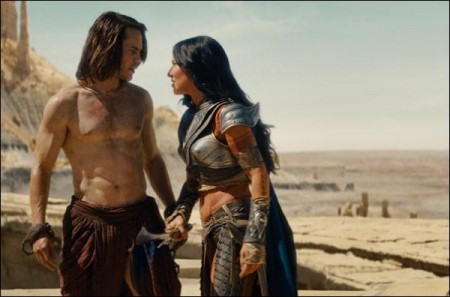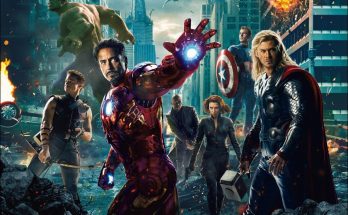Taglines: Lost in our world. Found in another.
Captain John Carter was a great warrior when he fought for his cause, the Confederate States of America, during the Civil War. He was really disappointed when the Confederates lost the war to the Union, but what hurt him most of all was the death of his family (a wife and a daughter) by an ungrateful Union troop. From both the Confederates defeat and, more to the point, the death of his family, he decides not to give a damn about anything worthwhile on the planet and to only look out for himself.
Three years later, in 1868, when trying to live a normal live by claiming gold for himself, he ran away for safety when encountered by the Apache Indians in the Arizona territory. He hid in a cave, where he found mystic cave drawings and gold. While in there, he was surprised by an appearance of a Thern and John kills him. The alien’s medallion transports John Carter to Barsoom (a.k.a. Mars).
He was then taken prisoner by another alien race, known as Tharks. He soon escapes and is caught in a great war fought between the red-skinned humans of Helium and Zodanga. Throughout the course of the film, John Carter has to learn the importance of the cause the people of Helium are fighting for and to put away his selfishness and fight for the ones he loves and for the freedom of Barsoom. This is how John Carter of Earth became John Carter of Mars.
John Carter is a 2012 American science fiction action film directed by Andrew Stanton from a screenplay written by Stanton, Mark Andrews, and Michael Chabon. The film was produced by Jim Morris, Colin Wilson, and Lindsey Collins, and is based on A Princess of Mars, the first book in the Barsoom series of novels by Edgar Rice Burroughs. John Carter stars Taylor Kitsch in the title role, Lynn Collins, Samantha Morton, Mark Strong, Ciarán Hinds, Dominic West, James Purefoy, and Willem Dafoe. The film chronicles the first interplanetary adventure of John Carter and his attempts to mediate civil unrest amongst the warring kingdoms of Barsoom.
Film Review for John Carter
I don’t see any way to begin a review of “John Carter” without referring to “Through Time and Space With Ferdinand Feghoot.” That was a series of little stories that appeared in the magazine Fantasy and Science Fiction from 1956 to 1973 and had a great influence on my development as a critic. In one of the Feghoot adventures, the hero finds himself on Mars and engaged in bloody swordplay. He is sliced in the leg. Then in the other leg. Then an arm is hacked off. “To hell with this,” Feghoot exclaims, unholstering his ray gun and vaporizing his enemies.
I may have one or two details wrong, but you understand the point: When superior technology is at hand, it seems absurd for heroes to limit themselves to swords. When airships the size of a city block can float above a battle, why handicap yourself with cavalry charges involving lumbering alien rhinos? When it is possible to teleport yourself from Earth to Mars, why are you considered extraordinary because you can jump really high?
Such questions are never asked in the world of “John Carter,” and as a result, the movie is more Western than science fiction. Even if we completely suspend our disbelief and accept the entire story at face value, isn’t it underwhelming to spend so much time looking at hand-to-hand combat when there are so many neat toys and gadgets to play with?
But I must not review a movie that wasn’t made. What we have here is a rousing boy’s adventure story, adapted from stories that Edgar Rice Burroughs cranked out for early pulp magazines. They lacked the visceral appeal of his Tarzan stories, which inspired an estimated 89 movies; amazingly, this is the first John Carter movie, but it is intended to foster a franchise and will probably succeed.
Burroughs’ hero is a Civil War veteran who finds himself in Monument Valley, where he has an encounter that transports him to the red planet Mars. This is not the Mars that NASA’s Rovers are poking into, but the Mars envisioned at the time Burroughs was writing, which the astronomer Percival Lowell claimed was criss-crossed by a system of canals. Luckily for Carter, it has an atmosphere that he can breathe and surface temperatures allowing him do without a shirt. In a delightful early scene, he finds that his Earth muscles allow him great leaps and bounds in the lower Martian gravity.
This attracts the attention of the inhabitants of Mars, represented by two apparently human cities at war with each other, and a native race called the Tharks, who look like a vague humanoid blend of weird green aliens from old covers of Thrilling Wonder Stories. They have four arms, and it was a great disappointment to me that we never saw a Thark putting on a shirt. John Carter feels an immediate affinity for the Tharks and also gets recruited into the war of the cities — choosing the side with a fiery beauty named Dejah Thoris (Lynn Collins, who is the movie’s best character).
John Carter is played by Taylor Kitsch, who co-starred with Collins in “Wolverine.” Yes, I agree Kitsch is a curious name for a star in action movies. Still, that is his real name, and one can wonder how many fans of “Wolverine,” for example, are familiar with the word or its meaning. As an actor, he is perfectly serviceable as a sword-wielding, rhino-riding savior of planets.
The film was directed by Andrew Stanton, whose credits include “A Bug’s Life” (1998), “Finding Nemo” (2003) and “WALL-E” (2008). All three have tight, well-structured plots, and that’s what “John Carter” could use more of. The action sequences are generally well-executed, but they’re too much of a muchness. CGI makes them seem too facile and not tactile enough. Although I liked the scene where Carter was getting his Mars legs with his first low-gravity steps, the sight of him springing into the air like a jumping jack could inspire bad laughs.
Does “John Carter” get the job done for the weekend action audience? Yes, I suppose it does. The massive city on legs that stomps across the landscape is well-done. The Tharks are ingenious, although I’m not sure why they need tusks. Lynn Collins makes a terrific heroine. And I enjoyed the story outside the story, about how Burroughs wrote a journal about what he saw and appears briefly as a character. He may even turn up in sequels. After all, he wrote some.
John Carter (2012)
Directed by: Andrew Stanton
Starring: Taylor Kitsch, Lynn Collins, Samantha Morton, Mark Strong, Ciarán Hinds, Dominic West, James Purefoy, Willem Dafoe, Polly Walker, Daryl Sabara, Pippa Nixon
Screenplay by: Andrew Stanton, Mark Andrews, Michael Chabon
Production Design by: Nathan Crowley
Cinematography by: Dan Mindel
Film Editing by: Eric Zumbrunnen
Costume Design by: Mayes C. Rubeo
Set Decoration by: Paki Smith
Art Direction by: David Allday, James Hambidge, Mark Harris, Phil Harvey, Joseph A. Hodges, John King, Naaman Marshall, Dean Wolcott, Robert Woodruff, Scott Zuber
Music by: Michael Giacchino
MPAA Rating: PG-13 for intense sequences of violence and action.
Distributed by: Walt Disney Pictures
Release Date: March 9, 2012
Hits: 127






